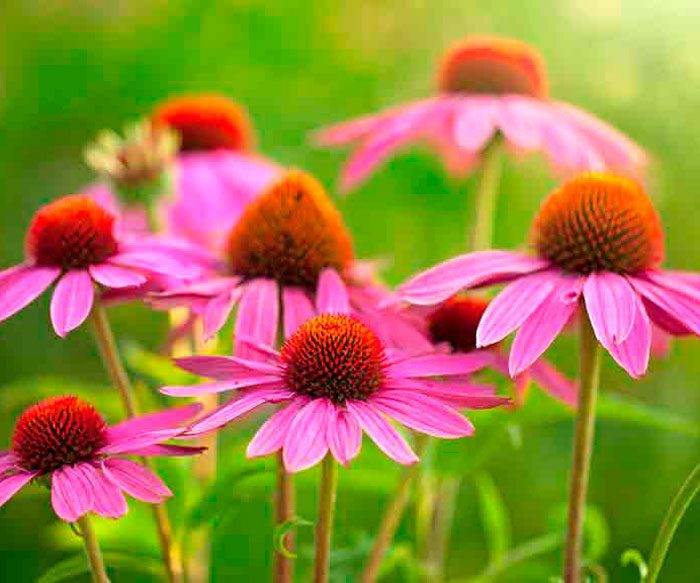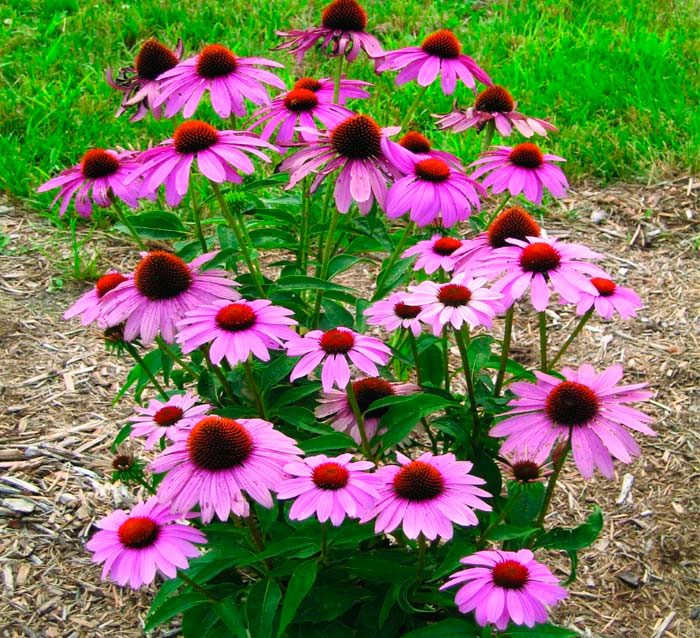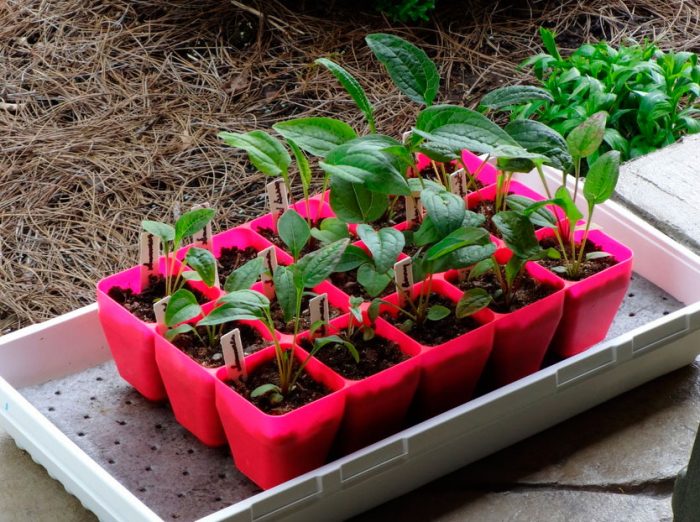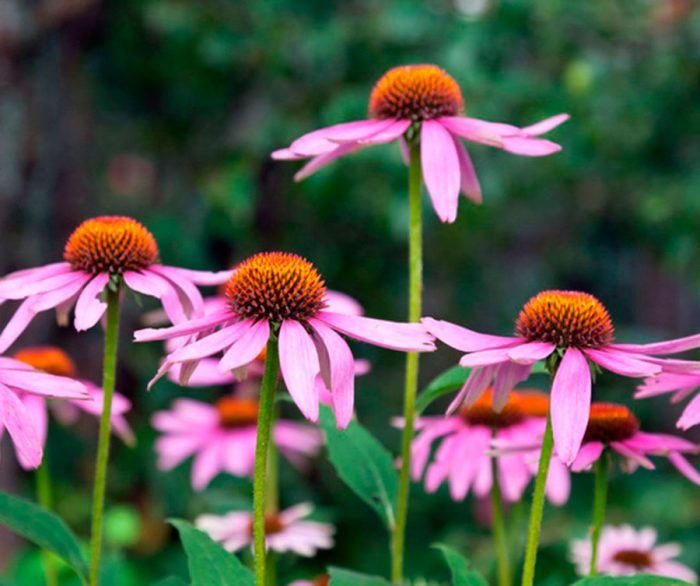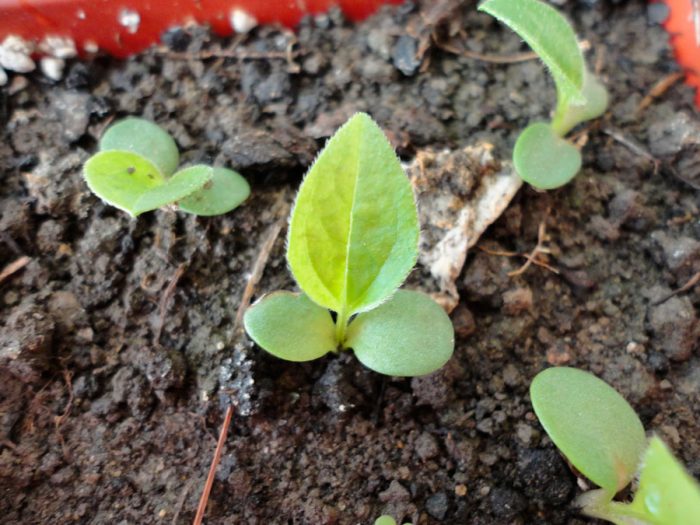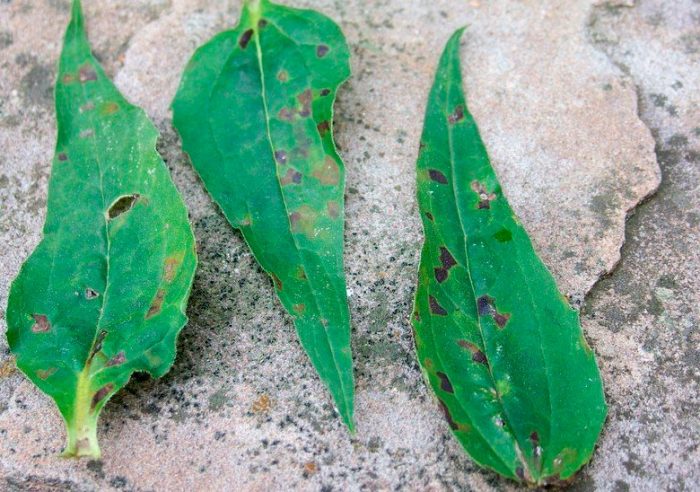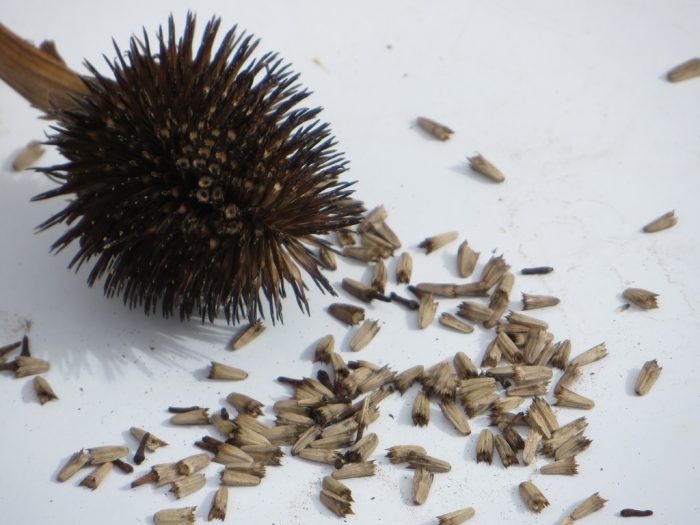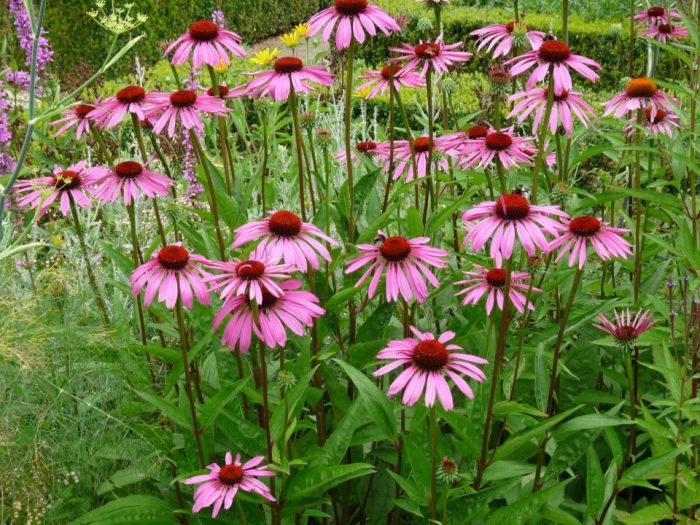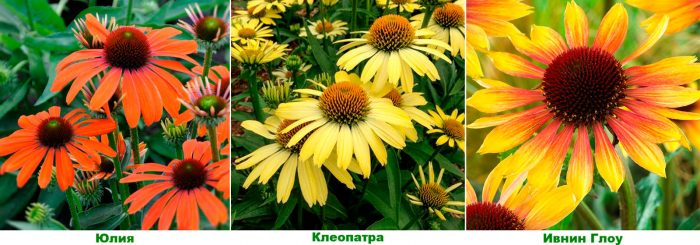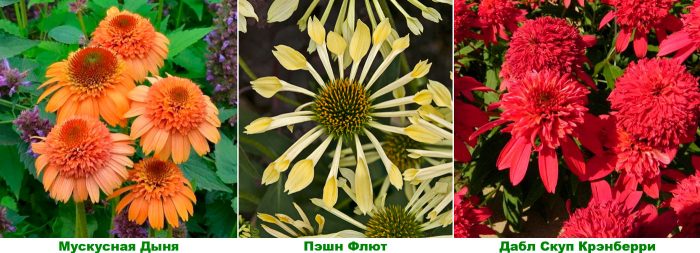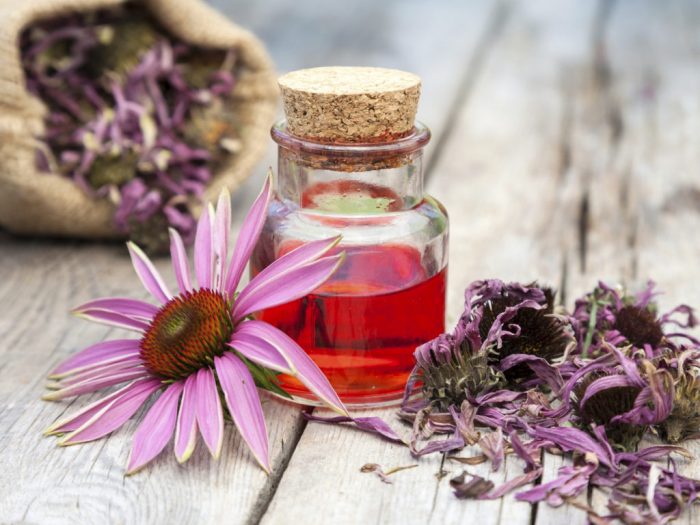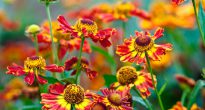The perennial flowering plant Echinacea is a member of the Asteraceae family. This genus unites about 9 species. The homeland of such a plant is the eastern part of North America. The name "Echinacea" is translated from Greek as "hedgehog or prickly like a hedgehog." The most popular is the type - Echinacea purpurea, or rudbeckia purpurea, such a plant is very widely used in non-traditional and official medicine, as well as in ornamental gardening. K. Linnaeus in 1753 first described such a plant, while he attributed it to the genus Rudbeky. However, forty years later, Echinacea was isolated into a separate genus, since there were significant differences between these plants.
Content
Features of echinacea
Echinacea is a herbaceous rhizome plant that is a perennial. The height of erect, rough shoots is about 100–150 cm. The basal leaf plates are very wide and oval in shape, their edge is serrated, they are located on very long petioles. Stem leaf plates are alternately located, practically sessile or sessile, have a lanceolate shape. The inflorescences include large baskets consisting of dark red or brown-red median tubular flowers, as well as reed marginal flowers of white, red or pink color. The fruit is a tetrahedral achene.
Planting echinacea outdoors
What time to plant
Echinacea can be planted in open ground in autumn or spring. This is most often done after dividing the echinacea bush. It is possible to grow this flower from seeds, however, in this way, as a rule, species of Echinacea are propagated; vegetative methods are used to propagate hybrid varieties.
A suitable planting site should be sunny and have nutritious, deeply cultivated, slightly alkaline or neutral soil. Light sandy soil or moist soil is not suitable for planting such a flower crop. If the soil is acidic, then this can be corrected by adding lime to it.
Landing features
When planting seedlings, the depth of the holes is made about 50 mm, while the distance between them should be about 30 centimeters.When planting divisions, the size of the hole should be only slightly larger than the root system of the plant being planted. Then a small amount of compost needs to be placed on the bottom, after which the echinacea is planted. The planted plants need watering. If the seedlings grow in containers, then you will need a larger planting pit, about 0.4 m. This pit needs to be 1/3 filled with a soil mixture consisting of compost, sand and garden soil (1: 1: 1). After that, the plant rolls over into a hole, and it is taken along with a lump of earth. The seedling must be planted at the same depth at which it grew in the container.
Echinacea Garden Care
Growing echinacea in your garden is easy, but there are a few rules you need to know. First of all, special attention should be paid to watering, it should be abundant and frequent, while watering the flowers is recommended in the evening. It is also very important that the site is always clean, so weed should be removed immediately after it appears.
Starting from the second year of growth, such a flower needs to be fed with wood ash with rotted compost, this has a positive effect on flowering, which becomes more abundant. Echinacea needs to be fed 2 times during the season: in spring, and when it fades. If you want to collect seeds, then cut off inflorescences that have withered, you must with part of the shoot up to the first green leaf plate.
Reproduction of echinacea
Gardeners prefer to propagate echinacea vegetatively by dividing the bushes. This procedure can be performed in the spring time in April, as well as in the autumn weeks during the period of massive leaf fall. The first division of the bush is made only after it is at least 4 or 5 years old. Remove it carefully from the soil, being careful not to injure the rhizome. Then the bush is divided into several parts, each of which should have 3 or 4 renewal buds. Delenki are planted in the same way as seedlings during the initial planting.
It has already been mentioned above that gardeners prefer to propagate the species Echinacea by seeds. The seeds are quite large. They are sown in spring time directly in open soil, since the best air temperature for the appearance of seedlings is 13 degrees. The sown seeds are not buried, but sprinkled on top with a thin layer of soil. However, experienced gardeners recommend growing such flowers in a seedling way, the fact is that the seedlings that appear are very delicate and can die due to the unstable weather that is observed in spring. For crops, containers or boxes are used. The seeds should be buried in the substrate only 5 mm, and on top they should be sprinkled with a thin layer of soil. Then the crops are watered from a spray bottle. The emergence of seedlings will have to wait for a relatively long time, sometimes they grow only 6 weeks after sowing. The grown and matured seedlings must be planted in the garden. Then they are watered in a timely manner, weeds are regularly removed from the site and the soil surface is loosened. Echinacea grown from seeds bloom most often in the second year of life, and in the first year they only grow a leaf rosette, which can reach a height of 15 to 20 centimeters.
Diseases and pests
Echinacea is highly disease resistant. Most often, the plant gets sick due to the fact that it is not properly looked after. If it is hot and humid in the summer, and there will also be temperature fluctuations, then the flowers can get sick with powdery mildew. Also, plants that are overfed with nitrogen are susceptible to this disease. In affected specimens, a whitish bloom forms on the surface of shoots, foliage and flowers. The diseased plant must be sprayed with Bordeaux mixture or colloidal sulfur.
Also, this flower can get sick with cercosporosis and septoria, which are also fungal diseases.In the affected bush, specks form on the leaf plates, which weaken it and gradually the plant dies. If the disease is at the initial stage of development, then it will be enough to cut off all the affected parts of the bush. If the disease is already running, then echinacea should be sprayed with a fungicidal preparation.
If the bush becomes infected with a viral disease, then the peduncles will deform, as well as yellowing and drying of the leaf plates. At the first signs of infection, diseased bushes need to be dug up and destroyed, while the site should be disinfected with a very strong solution of potassium manganese. Today these diseases are considered incurable.
In some cases, slugs, bedbugs and slobbering pennies settle on the bushes. When slugs appear, they must be collected by hand, while the shell of the nut must be evenly distributed over the surface of the site, it will become a serious obstacle for these gastropods. For the extermination of insect pests, insecticidal preparations are used, for example, Karbofos or Actellik.
For prevention purposes, it is recommended to strictly follow the rules of agricultural technology of this crop.
Echinacea after flowering
Seed collection
Echinacea seeds should be harvested at the very end of the season, and they should ripen right on the bush. But it should be borne in mind that the collection of seeds is carried out gradually, because their ripening does not occur at the same time. After the middle of the basket turns dark, you should remove the seeds from its center, while protecting your hand with a glove. Then the seeds are sorted out, removing the tubular flowers, and dried. Seeds must be sown immediately after harvest, as they remain viable for a relatively short time.
Preparation for wintering
Echinacea has a fairly high resistance to frost, but if there is very little snow in the winter, the bushes can freeze out. Winter frosts are especially dangerous for young plants that are not even a year old. To avoid freezing of the bush, in the last days of October, all shoots must be cut off from it, while the root collar is covered with a layer of mulch. The site itself must be covered with dried foliage or covered with spruce branches.
Types and varieties of echinacea with photos and names
In the wild, you can meet 9 different types of Echinacea, but at the same time, gardeners cultivate most often hybrids and varieties of Echinacea purpurea.
Echinacea purpurea (Echinacea purpurea)
The height of this perennial is about 1 meter. Rough shoots are straight. Basal leaf plates are collected in a rosette, they have a wide-oval shape, sharply tapering to winged long petioles. Stem leaf plates are alternate, rough and sessile, they have a lanceolate shape. The inflorescences are baskets, in the middle of which there are tubular flowers of brown-red color, and along the edges there are pink-purple reed flowers, which reach about 40 mm in length, they are pointed towards the top. Most popular varieties:
- Granatstern... The height of the bush is about 1.3 m. The baskets reach 13 centimeters in diameter. The ligulate flowers are purple in color and slightly pubescent, while they have 2 teeth at the top. And tubular flowers of brown color form a convex hemisphere, reaching 40 mm in diameter.
- Sonnenlach... The bush reaches a height of 1.4 m.The inflorescences of the basket reach 10 centimeters in diameter, they include lanceolate ligulate flowers of a dark red color, the length of which is about 35 mm, and at the tops they have 2 or 3 teeth, as well as tubular flowers that create a convex hemisphere of brown color.


Watch this video on YouTube
Echinacea Sunset (Echinacea x sunset)
This is a series of hybrids that were obtained using Echinacea paradoxical and Echinacea purpurea, which were the result of the work of R. Skola.These hybrids combine the best aspects of such plants: they have very large inflorescences, strongly branching shoots, a wonderful smell, curved petals and exquisite colors such as mustard, strawberry, mango or peach. Tubular petals are painted in henna color. Thanks to breeders, varieties were born in which baskets are painted in white, pink, light red, purple, orange and yellow. The most popular varieties of Echinacea garden are:
- Julia... It is related to the "Butterfly Kisses" variety series. The height of the dwarf bushes does not exceed 0.45 m. The rich orange baskets bloom in the first summer weeks, while they do not disappear until the end of the season.
- Cleopatra... This variety gets its name from the spectacular yellow butterflies. The rich yellow inflorescences reach 75 mm in diameter, the reed flowers are placed horizontally, which makes the baskets look like suns in a picture drawn by a child.
- Evening Glow... The inflorescences consist of yellow reed flowers, on which there is an orange strip of light pink hue, and in their middle there are tubular flowers that act as a dark cone.
- Cantaloupe... The baskets are melon-colored. The reed petals are arranged in 2 rows and look like an orange-pink frill. And the furry hemisphere in the middle of the flower consists of tubular flowers of a darker color.
- Passion Flute... This is a rather unusual variety. Yellow-golden ligulate flowers are twisted into tubes, in the middle there are tubular flowers of mustard-green color. This variety is related to the Lets Buggy variety series, these plants are distinguished by their resistance to drought, as well as their unpretentious care.
- Double Scoop Cranberry... This drought tolerant variety is very easy to care for. Cranberry-colored baskets are very effective and attractive to butterflies. It is recommended to use them when making bouquets.
Benefits of Echinacea
Echinacea herb contains polysaccharides, flavonoids, tannins, saponins, hydroxycinnamic and organic acids, phytosterols, resins and essential oils. The rhizome contains essential and also fatty oils, resins, enzymes, macroelements in the form of potassium and calcium and microelements selenium, silver, zinc, manganese, molybdenum and cobalt.
Means made from this plant are distinguished by antimicrobial, antifungal, antiviral and wound healing effects, they are used to strengthen the immune system, as well as for mental or physical fatigue. These funds are decoctions, extracts, juice and infusions of echinacea.
Tincture of this plant helps to increase potency and quick healing of burns. The juice squeezed from fresh flowers is used in alternative medicine to heal wounds, and when consumed internally, blood clotting accelerates.
Echinacea purpurea is popular in a large number of countries. Funds from such a flower in Germany are used in the treatment of tonsillitis, tonsillitis, chroniosepsis and other inflammatory diseases. SA Tomilin is a Russian professor who argued that Echinacea purpurea has the same medicinal properties as ginseng.
Below are recipes for echinacea remedies, which, if necessary, can be made at home:
- Tincture... Take a 500 ml glass jar and fill it to the top with freshly cut echinacea flowers. Then fill them with vodka and close the jar with a twist lid. Remove the container in a dark place for 40 days. Then the tincture is poured into another container. They drink it in 15 drops, which are dissolved in 1/3 cup of tea or water, on an empty stomach 30 minutes before a meal. It helps with overwork, depression and infectious disease.
- Decoction of roots... Combine 300 milligrams of water with 1 large spoonful of crushed echinacea roots.The mixture is placed in a water bath and boiled for 30 minutes. After the broth has cooled, strain it. They drink it 3 or 4 times a day, 1-2 large spoons. It helps with colds, chronic fatigue and acute infectious diseases.


Watch this video on YouTube
Contraindications
Products from this plant sometimes cause an allergic reaction. They cannot be used by pregnant women, as well as by those who are breastfeeding, as well as by people suffering from multiple sclerosis, progressive tuberculosis, leukemia, collagenosis. And also they cannot be used by people with individual intolerance. In general, it is strongly recommended to consult a specialist before using such drugs.

